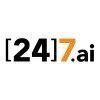
i
PTC
Filter interviews by
PTC Interview Questions and Answers
42 Interview questions
Generate Fibonacci series in Java using iterative and recursive methods.
Fibonacci series starts with 0 and 1, and each subsequent number is the sum of the previous two.
Iterative approach: Use a loop to calculate Fibonacci numbers up to n.
Recursive approach: Define a function that calls itself to calculate Fibonacci numbers.
Example of iterative method: for (int i = 0; i < n; i++) { ... }
Example of recursive meth...
Priority refers to the urgency of fixing a defect, while severity indicates the impact of the defect on the system.
Priority is about the order in which defects should be fixed, e.g., a high-priority bug might be a login failure.
Severity measures the impact of a defect, e.g., a critical severity issue could be a system crash.
A low-severity issue might be a typo in the UI, but if it's in a high-visibility area, it c...
Agile methodology is an iterative approach to software development that emphasizes flexibility, collaboration, and customer feedback.
Focuses on delivering small, incremental updates to software, allowing for quick adjustments based on user feedback.
Utilizes short development cycles called 'sprints' (typically 1-4 weeks) to promote rapid delivery and continuous improvement.
Encourages collaboration among cross-funct...
A sprint is a time-boxed period in Agile development where a specific set of tasks is completed.
Typically lasts 1 to 4 weeks.
Focuses on delivering a potentially shippable product increment.
Includes planning, execution, review, and retrospective phases.
Example: A team may plan to develop a new feature in a 2-week sprint.
End to end application architecture refers to the overall structure and design of an application from the front-end user interface to the back-end server infrastructure.
Front-end: Includes user interface design, user experience, and client-side technologies like HTML, CSS, and JavaScript.
Back-end: Involves server-side technologies, databases, and application logic.
Middleware: Connects the front-end and back-end co...
A program for HashMap implementation in Java
HashMap is a data structure that stores key-value pairs
Use put() method to add key-value pairs to HashMap
Use get() method to retrieve values based on keys
HashMap allows null keys and values
Example: HashMap<String, Integer> map = new HashMap<>()
Test cases for items in an interview cabin ensure functionality, safety, and user experience during the interview process.
Check the functionality of the interview chair: Ensure it is adjustable and comfortable for long periods.
Test the lighting: Verify that the lighting is adequate and does not create glare on screens or documents.
Inspect the table: Ensure it is sturdy and has enough space for interview materials ...
Reverse a linked list
Iterate through the linked list and reverse the pointers
Use three pointers to keep track of current, previous, and next nodes
Update the next pointer of each node to point to the previous node
Implement stack using array in C++
Create a class with an array to store elements
Implement push() and pop() functions to add and remove elements
Include functions like isEmpty() and isFull() to check stack status
Test cases for a login page include various scenarios to ensure functionality, security, and user experience.
Verify valid login with correct username and password.
Check login with incorrect username or password to ensure error message displays.
Test login with empty username and password fields to confirm validation messages.
Validate password visibility toggle functionality (show/hide password).
Ensure 'Remember Me'...
PTC Interview Experiences
68 interviews found
It was oncampus opportunity where in 1st round I was OA where aptitude and technical questions was asked all MCQ on the mttle platform
(4 Questions)
- Q1. Oops concepts was asked and told t9 implement as well
- Q2. One DSA question easy - medium level
- Q3. Login page was given and was asked for the possible test cases coming in my mind as it was a QA role
- Ans.
Test cases for a login page include various scenarios to ensure functionality, security, and user experience.
Verify valid login with correct username and password.
Check login with incorrect username or password to ensure error message displays.
Test login with empty username and password fields to confirm validation messages.
Validate password visibility toggle functionality (show/hide password).
Ensure 'Remember Me' opti...
- Q4. One sql question medium level
(4 Questions)
- Q1. It was manegarial round where some technical as well as behaviourial questions was asked
- Q2. Google home page was given and was asked for the test cases
- Ans.
Test cases for the Google home page include functionality, usability, and performance checks to ensure a seamless user experience.
Verify the search functionality by entering various queries (e.g., 'weather', 'news').
Check the responsiveness of the page on different devices (mobile, tablet, desktop).
Test the loading time of the homepage under different network conditions.
Ensure that the 'I'm Feeling Lucky' button redire...
- Q3. 2 DSA questions was asked easy - medium level
- Q4. Some behaviourial questions like where do you want to see yourself in next 5 years
(2 Questions)
- Q1. Expalination of my project
- Q2. My family background
Interview Preparation Tips
I appeared for an interview before Jun 2024, where I was asked the following questions.
- Q1. Relative electrical nowledge based questions
- Q2. Power system of Electrical and Electronics
- Ans.
Power systems in electrical engineering manage generation, transmission, and distribution of electrical energy efficiently.
Power Generation: Involves sources like thermal, hydro, and renewable energy (e.g., solar panels).
Transmission: High-voltage lines transport electricity over long distances to reduce losses.
Distribution: Local networks deliver electricity to consumers, ensuring reliability and safety.
Grid Managemen...
Interview Preparation Tips
I applied via Recruitment Consulltant and was interviewed in Jul 2024. There were 2 interview rounds.
(2 Questions)
- Q1. Program for HashMap
- Ans.
A program for HashMap implementation in Java
HashMap is a data structure that stores key-value pairs
Use put() method to add key-value pairs to HashMap
Use get() method to retrieve values based on keys
HashMap allows null keys and values
Example: HashMap<String, Integer> map = new HashMap<>()
- Q2. Test cases for any materialistic things in interview cabin
- Ans.
Test cases for items in an interview cabin ensure functionality, safety, and user experience during the interview process.
Check the functionality of the interview chair: Ensure it is adjustable and comfortable for long periods.
Test the lighting: Verify that the lighting is adequate and does not create glare on screens or documents.
Inspect the table: Ensure it is sturdy and has enough space for interview materials like ...
(2 Questions)
- Q1. Why you want to join
- Ans.
I am impressed by the company's commitment to quality and innovation.
I admire the company's reputation for excellence in product quality.
I am excited about the opportunity to contribute to a team that values continuous improvement.
I believe in the company's mission and values, and I see potential for growth and development within the organization.
- Q2. Why you left previous organisation
- Ans.
Seeking new challenges and growth opportunities
Desire for career advancement
Looking for a more challenging role
Seeking new learning opportunities
Relocation to a different city
Company downsizing or restructuring
I applied via LinkedIn and was interviewed in Jul 2024. There were 2 interview rounds.
(3 Questions)
- Q1. Basic Solid mechanics.
- Q2. Production technology
- Q3. CAD functionality
Generic, engineering graphics included.
Interview Preparation Tips
I applied via Campus Placement and was interviewed in May 2024. There were 2 interview rounds.
2 hours and conducted online.
(3 Questions)
- Q1. Offline. i had 3 interview round. first with their team members, then with manager, and final was HR.
- Q2. Introduction , java oops concept like what is inheritance, polymorphism and how it is different etc etc..
- Q3. Tell me the name of team who conducted your 1st round (to check observation and listening skills)
Interview Preparation Tips
I appeared for an interview in Feb 2025, where I was asked the following questions.
- Q1. Technical related to testing
- Q2. Testing process followed by previous projects
- Q3. Testing tools related
Interview Preparation Tips
I applied via Naukri.com and was interviewed in Sep 2024. There was 1 interview round.
(2 Questions)
- Q1. String coding question
- Q2. File operations
(2 Questions)
- Q1. Describe end to end application architecture
- Ans.
End to end application architecture refers to the overall structure and design of an application from the front-end user interface to the back-end server infrastructure.
Front-end: Includes user interface design, user experience, and client-side technologies like HTML, CSS, and JavaScript.
Back-end: Involves server-side technologies, databases, and application logic.
Middleware: Connects the front-end and back-end compone...
- Q2. Last issue faced
- Ans.
Last issue faced was with software compatibility during testing phase.
Encountered compatibility issues between the software being tested and the testing environment
Had to troubleshoot and identify the root cause of the compatibility issues
Collaborated with developers to find solutions and implement necessary changes
Performed regression testing to ensure the compatibility issues were resolved
(1 Question)
- Q1. Why are you leaving
- Ans.
Seeking new challenges and growth opportunities in a different environment.
Looking for new challenges and opportunities for growth
Interested in exploring different industries or technologies
Seeking a better work-life balance
Want to relocate to a different city or country
Code snippets, MCQ questions
(2 Questions)
- Q1. Technical Round
- Q2. Java, OOP, SQL , Collection , Recursion, Stack/Queue
(1 Question)
- Q1. Formal HR round
Online assessment (on campus) there were some coding questions
(2 Questions)
- Q1. Basics of c++, projects, situation based questions, puzzles
- Q2. Water jug puzzle , patterns
Top trending discussions







PTC Interview FAQs
Some of the top questions asked at the PTC interview -
The duration of PTC interview process can vary, but typically it takes about less than 2 weeks to complete.
Tell us how to improve this page.
PTC Interviews By Designations
- PTC Intern Interview Questions
- PTC QA Engineer Interview Questions
- PTC Software Developer Interview Questions
- PTC Software Engineer Interview Questions
- PTC Java Developer Interview Questions
- PTC Software Specialist Interview Questions
- PTC Technical Lead Interview Questions
- PTC Senior Software Developer Interview Questions
- Show more
Interview Questions for Popular Designations
Overall Interview Experience Rating
based on 68 interview experiences
Difficulty level
Duration
Interview Questions from Similar Companies
|
Software Specialist
176
salaries
| ₹6.5 L/yr - ₹20 L/yr |
|
Senior Software Specialist
98
salaries
| ₹13.5 L/yr - ₹24.5 L/yr |
|
Technical Lead
95
salaries
| ₹11 L/yr - ₹31 L/yr |
|
QA Specialist
88
salaries
| ₹8.2 L/yr - ₹15.3 L/yr |
|
Software Analyst
84
salaries
| ₹7.5 L/yr - ₹15.5 L/yr |

Autodesk

24/7 Customer

Thomson Reuters

Oracle Cerner
- Home >
- Interviews >
- PTC Interview Questions













